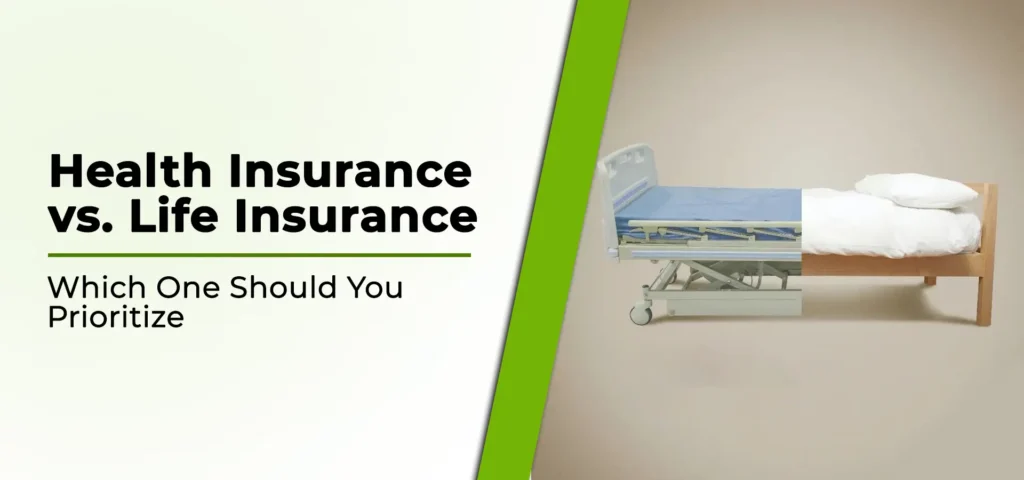When people begin to think about safety for their family and their own future, insurance often comes to mind because it offers protection in uncertain times, yet the question remains whether one should consider health insurance first or life insurance first, and this choice can feel confusing because both policies serve different roles but at the same time they complement each other in protecting people from risks they cannot control.
This writing explains the meaning of both insurance types, explains their working structure, highlights the differences, shows possible priority for different stages of life, and then shares some suggestions for a balanced approach so the reader can decide with a clearer mind.
What Are These Two Insurances
Health Insurance
Health insurance is a financial tool that pays medical bills during sickness or injury, and it gives a safety net against high hospital costs that can quickly exhaust savings. People pay a regular premium to the insurer and in exchange the insurer covers hospital stays, medicines, tests, surgery, or even preventive health checkups, sometimes in cashless mode and sometimes through reimbursement after documents are submitted. Most plans last for one year with an option to renew, and benefits cover both the policyholder and dependent family members, which means it creates a shield against rising healthcare expenses.
Life Insurance
Life insurance provides monetary help to the nominee or dependent family if the insured person passes away, and it creates a financial cushion that replaces the income that disappears after death. The person pays premiums over a fixed period, and if death happens during that period, the policy pays a lump sum or structured payout to the beneficiary. Life policies have different forms such as pure term cover, whole life as well as endowment, but the most straightforward and budget friendly plan is usually a term cover which focuses on pure protection. The duration can be short, medium, or lifelong, and the person can choose beneficiaries such as spouse, children, or parents who depend on them.
Key Differences and How They Complement Each Other
Both types are very different in purpose yet they work together, and comparing them helps to understand the role each one plays in human life.
| Aspect | Health Insurance | Life Insurance |
| Risk addressed | Medical treatment expenses | Financial loss after death |
| When benefits arrive | During medical need while alive | After death during policy period |
| Savings element | Usually none | Some plans create savings or investment |
| Duration | Usually short and renewable | Short, medium, or lifelong |
| Who benefits | Policyholder and dependents using treatment | Family or nominee receiving payout |
| Use of money | Hospitals, medicines, diagnostics | Debt repayment, family needs, education |
Health insurance protects from sudden medical shocks that can happen any time, while life insurance supports loved ones when the income earner is not around. Together they build a wider shield because health problems may strike suddenly while death leaves families without financial support, so carrying both offers more complete protection.
When Should One Take Priority Over the Other
Money is limited and not everyone can buy both at the same time, and in such cases priority depends on personal life stage, financial responsibility, and family condition.
When the budget is low
Medical treatment is unpredictable and expenses can rise suddenly, so health insurance becomes the first choice when the budget is limited. A single hospitalisation can drain years of savings, and this risk is more immediate than death in early years of adulthood. Hence a basic health plan becomes the starting step in building security.
When there are dependents or debt
If a person has children, a spouse, or ageing parents, then life insurance becomes more urgent because the absence of income after death can destroy financial balance. Loans such as home mortgages or personal borrowings may also fall on the family, and life cover prevents that burden. At younger age the premiums are lower, so delaying purchase only increases future cost and reduces eligibility.
Different life stages
| Life stage | Priority | Reason |
| Single, young, no dependents | Health insurance | Risk of sudden illness higher than family responsibility |
| Young with spouse or children | Both required | Balance between hospital bills and dependent security |
| Middle age with mortgage and family | Life insurance | Family depends on income and debt repayment |
| Older age, near retirement | Health insurance | Medical needs rise, life cover less required |
Affordability factor
Premiums rise with age for both products, and medical inflation makes health cover expensive every year, while life cover cost increases when health declines. Early purchase of both products provides stability at a reasonable cost, so waiting is rarely beneficial.
How to Strike the Right Balance
Every family has unique needs, and making choices requires careful steps that can be simple yet thoughtful.
- Calculate possible medical costs by considering family health background and compare that with available savings.
- Review income dependency of spouse, children, and parents and also calculate liabilities like loans.
- Buy a health policy even if coverage is small because some protection is better than none.
- Buy a term life plan early because it is cheaper and provides high coverage.
- Add optional riders such as accident or critical illness only when the price justifies the extra benefit.
- Increase coverage with time as income grows and responsibilities change.
- Do not miss premium payments because a lapsed plan has no use, and automatic debit can help.
- If possible take advantage of group covers from employers but never rely only on them since they may end when employment ends.
Conclusion and Recommendation
Choosing between health insurance and life insurance is not a simple matter, and people often struggle because both are connected to protection, but each addresses a different risk. If money allows, one should carry both together, but if a choice must be made at the beginning, a health policy comes first since medical emergencies are sudden and immediate. However waiting too long for life insurance is unwise because premiums rise every year and family needs remain constant, so both types should eventually be part of a long term plan.
Health insurance gives financial support while living with illness, and life insurance provides financial help to loved ones after death, and for that reason the best approach is not choosing permanently but starting where needed most and then moving steadily toward full coverage, because safety today and safety tomorrow both matter for peace of mind.

